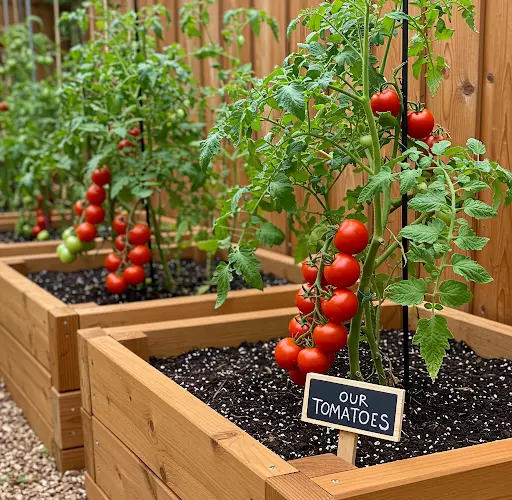Little-Known Method of Growing Tomatoes – Lots of Fruit, Easy, and Low-Maintenance
Tomatoes are one of the most popular vegetables to grow at home, but many people are surprised to learn that they can be cultivated successfully with minimal care using simple and space-saving methods. This little-known technique focuses on efficiency, resourcefulness, and making gardening accessible even for those without much time or space.
If you’ve struggled with growing tomatoes in the past—dealing with disease, low yields, or too much maintenance—this guide will walk you through an alternative way that’s both beginner-friendly and highly productive.
Why Try This Method?
This growing approach uses repurposed containers, rich organic soil, and natural supports to create the ideal environment for tomatoes to thrive. It minimizes watering needs, improves root development, and maximizes fruit production with little effort.
Benefits include:
-
Space-saving and perfect for patios, balconies, or small yards
-
Low-maintenance, ideal for busy or beginner gardeners
-
Reduces the risk of pests and soil-borne diseases
-
Encourages deep rooting and stable plant structure
-
Promotes higher fruit yield with fewer inputs
What You’ll Need
This method works best with cherry or compact tomato varieties, but larger types can also be grown with some adaptation. Here’s what you’ll need:
-
A large container (like a 20-liter bucket, grow bag, or old basin)
-
Tomato seedlings (cherry or determinate types are best)
-
Quality potting mix or garden soil enriched with compost
-
Organic fertilizer or natural amendments (e.g. banana peel, crushed eggshells)
-
A watering bottle or simple irrigation system
-
Mulch material (dry leaves, straw, rice husks)
-
Sturdy support stakes, cages, or ropes
Step-by-Step Instructions
1. Prepare the Container
Choose a deep and wide container (at least 12 inches deep) with proper drainage holes at the bottom. The deeper the container, the better the root system can develop.
Fill the container with a mix of:
-
60% rich potting soil or loamy garden soil
-
30% organic compost (homemade or store-bought)
-
10% natural fertilizers like vermicompost or aged manure
You can enhance the soil with natural ingredients like:
-
Crushed eggshells (calcium for strong stems)
-
Banana peel pieces (potassium boost for fruiting)
-
A few teaspoons of wood ash (adds potassium and phosphorus)
Mix everything well before planting.
2. Plant the Seedlings
Choose healthy seedlings that are 4–6 inches tall. Dig a small hole in the center of the container and bury the seedling deeply, covering most of the stem. Tomatoes form roots along buried stems, which strengthens the plant.
Water thoroughly after planting to help the roots settle.
3. Add Support Early
Tomatoes need support as they grow. Install a stake, trellis, or vertical string at the time of planting to avoid disturbing roots later. For small spaces, a single bamboo stake or spiral rod works perfectly.
Tie the plant gently to the support using soft twine or plant clips.
4. Watering and Mulching
Water the plant deeply every few days rather than light daily watering. This encourages roots to grow deeper. One clever technique is to use a recycled plastic bottle: punch small holes in the cap and bury it next to the plant. Fill it with water, and it will release moisture slowly near the roots.
Apply mulch around the base of the plant using dry leaves, rice husks, or shredded newspaper. Mulch helps retain soil moisture, suppress weeds, and regulate temperature.
5. Fertilizing and Care
Feed your plant every 10–14 days with a diluted liquid fertilizer or compost tea. Tomato plants are heavy feeders, especially during flowering and fruiting stages. Keep an eye on the leaves: pale yellow indicates a nitrogen deficiency, while curled leaves may suggest potassium imbalance.
Prune off the lower leaves as the plant grows, especially those that touch the soil. Remove suckers (small shoots that appear in leaf joints) to direct the plant’s energy toward fruit production.
Harvest Time and Tips
Depending on the variety, tomatoes usually begin to ripen 60–80 days after transplanting. Harvest when fruits are firm and fully colored.
Tips for bigger harvests:
-
Grow in full sun (at least 6–8 hours of direct sunlight daily)
-
Avoid overhead watering to prevent fungal diseases
-
Rotate containers or change soil each season if replanting
-
Plant basil or marigold nearby to repel pests naturally
Low Effort, High Reward
What makes this method so special is its simplicity. By focusing on healthy soil, deep watering, and clever use of containers, anyone can enjoy a bountiful tomato harvest—even without a large garden. It’s also a great way to recycle and make gardening sustainable.
Final Thoughts
Tomatoes don’t have to be complicated. With this lesser-known yet highly effective method, you’ll find growing tomatoes to be not just possible, but incredibly rewarding. Whether you’re looking to add fresh produce to your meals, start a garden on a budget, or just enjoy the joy of watching plants thrive, this easy and low-maintenance method is worth trying.
Start with one container, give it a little care, and soon you’ll be enjoying clusters of sweet, juicy tomatoes straight from your own magical mini-garden.



